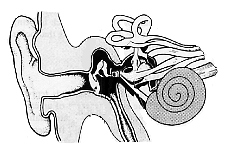Sounds Around UsOur surroundings are full of sounds from both nature and man-made things. In order to say something meaningful about the sounds around us, we must begin by thinking about why we need ears.

Our ears are always "on." We awaken if someone shouts in our ears, but not if something is waved before our closed eyes. When ears give the signal, the body reacts and becomes attentive. Our hearing apparatus has not changed significantly since we climbed down from the trees and moved out onto the savannahs in Africa; situated on each side of the head, they allow us to distinguish from which direction sounds originate, including from behind.

Human eyes face front, enabling us to see what is ahead and to effectively grasp and hold weapons. Hearing is also an integral part of humankind's survival instinct, telling us about wolves in the vicinity, for example, and whether they were nearby, motionless or moving, approaching or circling. Or perhaps there were no wolves at all, but something harmless - leaves rustling in the wind or something we could eat. There was also danger in sounds made by other people, and ears assisted in distinguishing their movements as either innocent or calculated and watchful.
The ears are connected in such a way that strong signals reach the brain first, to ensure important information is received. In other words, if something large comes thundering through the woods, the brain will first consider this sound before it evaluates the meaning of a soft whispering, even though the whispering actually came first.
Nature is full of sounds that tell us about what happens in our surroundings, what is safe or unsafe. People who live in California will likely react quickly to a deep rumbling sound because they know what an earthquake sounds like. No matter where one lives or which culture creates a sense of familiarity, the ears fill the consciousness with sounds that influence mood and humour. Background music of sounds of water lapping onto the beach, for example, creates a sense of well-being while alarm clocks, brakes and sirens signal the importance of being aware. We have a need to understand and recognize sounds; to know what creates them. Electroacoustic music plays on this need. Listeners unfamiliar with this music probably experience discomfort in not knowing exactly what has made the sounds, in the freedom to fill the space with their own content and meaning.
We may not think about it very often, but we actually hear sounds of some kind or another all the time. One might consider using a music class to just listen quietly for a while, with eyes closed, and then write down all the details of what one has heard. Or take a "sound walk" and follow those sounds that are most interesting! Or perhaps record sounds on a tape recorder and do something with them in the computer? Create a new sound journey...
|